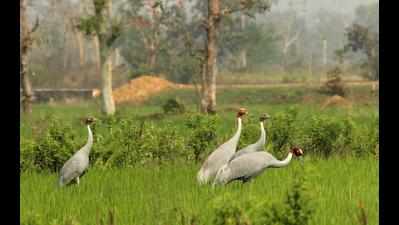- News
- City News
- nagpur News
- Sarus cranes number up in Gondia and Balaghat
Trending
This story is from June 21, 2020
Sarus cranes number up in Gondia and Balaghat

As per the six-day estimation exercise conducted from June 13 to 18, 45 sarus cranes were recorded in Gondia district, 2 in Bhandara and 1 in Chandrapur. 56 were found in Balaghat district of Madhya Pradesh
Nagpur: Despite threats like poaching and electrocution, the number of sarus cranes has marginally increased by 6 in Gondia in Maharashtra and its landscape spread over Balaghat district in the neighbouring Madhya Pradesh.
As per the six-day estimation exercise conducted from June 13 to 18, 2020, 45 sarus cranes were recorded in Gondia district while 56 were found in neighbouring Balaghat and 2 and 1 each in Bhandara and Chandrapur districts respectively.
During the 2019 estimation during the same period, there were 42 birds in Gondia, 52 in Balaghat and 3 in Bhandara and 1 in Chandrapur. In 2020, 104 birds have been recorded with a standard error of 4 birds.
“We expect the birds to be 108, but due to the overlapping jurisdiction, we consider 104 to be maximum figure,” said Sawan Bahekar, president, Sustaining Environment and Wildlife Assemblage (SEWA), which is monitoring the tall birds since 2004, when their number was just five.
Gondia and Balaghat are divided by Bagh and Wainganga rivers and the sarus habitat is somewhat similar on both sides and hence the estimation is done on both sides. Gondia and Bhandara are the only two districts in Maharashtra where sarus cranes are found. A solo bird has also been recorded in Chandrapur. These birds are listed in Schedule IV of the Wildlife (Protection) Act 1972. These birds are listed as ‘vulnerable’ species in the International Union for Conservation of Nature (IUCN).
Bahekar called for a joint conservation action plan to save sarus. As of now, there is no special program or official awareness drives against the use of pesticides among farmers to conserve the bird species. Most of these birds are also poached by fishermen if caught in nets and electrocuted accidentally too.
“Despite the death of birds, the number going up is a positive sign. In the last several years, we have been reaching hundreds of farmers to spread awareness about the use of the deadly pesticides,” says Bharat Jasaani, one of the coordinators of the exercise.
As per the six-day estimation exercise conducted from June 13 to 18, 2020, 45 sarus cranes were recorded in Gondia district while 56 were found in neighbouring Balaghat and 2 and 1 each in Bhandara and Chandrapur districts respectively.
During the 2019 estimation during the same period, there were 42 birds in Gondia, 52 in Balaghat and 3 in Bhandara and 1 in Chandrapur. In 2020, 104 birds have been recorded with a standard error of 4 birds.
“We expect the birds to be 108, but due to the overlapping jurisdiction, we consider 104 to be maximum figure,” said Sawan Bahekar, president, Sustaining Environment and Wildlife Assemblage (SEWA), which is monitoring the tall birds since 2004, when their number was just five.
At least 23 self-motivated teams of SEWA volunteers scanned the sarus habitats at 80 spots in Gondia and Bhandara and 21 teams in Balaghat districts for six consecutive days between 5am and 10am. Deputy conservator (DyCF) from Gondia S Yuvraj and South Balaghat DFO Anurag Kumar and forest staff from both states coordinated the estimation exercise.
Gondia and Balaghat are divided by Bagh and Wainganga rivers and the sarus habitat is somewhat similar on both sides and hence the estimation is done on both sides. Gondia and Bhandara are the only two districts in Maharashtra where sarus cranes are found. A solo bird has also been recorded in Chandrapur. These birds are listed in Schedule IV of the Wildlife (Protection) Act 1972. These birds are listed as ‘vulnerable’ species in the International Union for Conservation of Nature (IUCN).
Bahekar called for a joint conservation action plan to save sarus. As of now, there is no special program or official awareness drives against the use of pesticides among farmers to conserve the bird species. Most of these birds are also poached by fishermen if caught in nets and electrocuted accidentally too.
“Despite the death of birds, the number going up is a positive sign. In the last several years, we have been reaching hundreds of farmers to spread awareness about the use of the deadly pesticides,” says Bharat Jasaani, one of the coordinators of the exercise.
End of Article
FOLLOW US ON SOCIAL MEDIA










